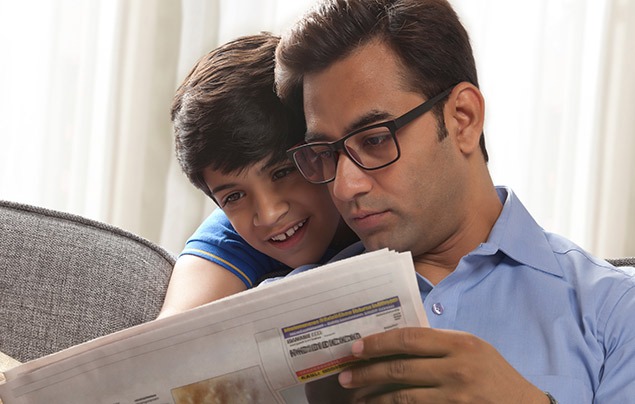How to spot fake news: teach your kids to be expert fact-checkers
Reliable news and fake stories live together on the internet. So, here’s how to help your family figure out the truth…
On a daily basis, news organisations call out facts versus lies told by people on different sides of controversial issues. And our social media feeds are likely flooded with real news and misinformation that look exactly alike. So the key question is – how to spot fake news from the real stories?
Turns out, most people find it difficult sometimes. An experiment conducted by the Massachusetts Institute of Technology found that adults believed false “news” reports about 20 percent of the time. Meanwhile, a poll by Common Sense Media found that less than half of kids surveyed said they could tell false stories from real ones.
It’s challenging for kids to figure out how to spot fake news when even adults sometimes struggle. So, we’re here to help!
The following tips from the Nat Geo book Breaking the News offer simple steps kids can follow to tell the difference between authentic news and misinformation. Plus, they’ll help encourage children to think independently and become responsible digital citizens—so kids are not only responsible for themselves, but also for what they share with others.
Stop before you click.
Studies show that people are much more likely to click on a headline or share a post if it makes them feel happy, angry, or excited. This is especially true among young people, who are some of the most likely to read clickbait. And yet the most provocative headlines often turn out to be the most misleading.
The best advice for kids and adults is that when we feel a strong, knee-jerk reaction, we should resist the urge to share the post immediately.
Stop, breathe, and think about what’s making you feel that way. Is it a shocking headline or image? Does the language make wild statements without facts to back it up? These are tell-tale signs the post may be fake.
And because headlines can be deceiving, kids should remember to read the whole article or post before sharing.
Go to the source.
Children might not be glued to the daily news, but they’ve probably absorbed some conflicting information. If your child feels confused, encourage them to ask the one question that will lead to the truth: What’s the source of the information?
Authentic news will include sources for all information presented. (And if anonymous sources are used, the story should explain why their information is withheld.)
Explain that a reliable news story will provide sources for different sides of an issue, then work together to identify the sources in the story. Look for names of the people quoted as well as the organisations that provide the facts and figures.
And if sources aren’t provided? That’s a major red flag that the news report isn’t legitimate.
Here at National Geographic Kids, we strive to help young readers engage with accurate news from around the world. That’s why every issue of National Geographic Kids magazine contains Cool News stories – informative updates about real-world discoveries, actions and more!
Plus, in the UK, our Junior Explorers’ Club members receive a weekly ‘Good News’ email, packed with positive news from the worlds of science, nature and conservation. We hope this helps our readers and their families combat eco-anxiety and feel hopeful for the planet’s future. Find out more.
Fact-check suspicious stories.
Young people don’t always know not to believe everything they read. Here are a few easy tricks that kids can use to tell if a fishy-sounding story could be a hoax, a wild conspiracy theory or misinformation.
- – Do an internet search on the article’s headline or the title of the post to see if the story has already been identified as false. If the story is real, other reliable sources will likely have written stories about the same topic.
- – If the post includes a photo, check for signs that the photo could be a fake. Is the image blurry in places? Are any shadows out of place? Do you see duplicated images in the background, or does it look like different images have been pasted together? Kids can also do an online image search to see if the photo has been identified as fake.
- – If the article includes a video, search its title to see who created it. Does the person seem legitimate?
- – If the story comes from an organisation or a famous person’s social media account, make sure the account is real. For example, some platforms put blue ticks next to the verified accounts of well-known people.
- – Check the date of the story. If it isn’t recent, the facts could be out of date.
- – Go back to the original question: What’s the source of this information?
Most importantly, if something seems too far-fetched to be true, or it just feels wrong, trust your instinct – don’t share it. (But if something scary is true – here’s how to talk to kids about frightening news.)
Know how to spot propaganda.
Throughout history, propaganda has followed a tried-and-true formula that’s simple yet remarkably effective – and at times, very destructive.
See if your child can identify any of these common propaganda techniques used by people or organisations covered in the news…
- – Playing to people’s emotions – such as their hopes, fears, anger or sympathy – rather than relying on facts.
- – Sticking to simple messages and catchy slogans, rather than providing complex or in-depth information.
- – Speaking to a specific audience. For example, politicians craft their messages to appeal to the people whose support they want to win.
- – Blaming someone else for problems. One of the most harmful forms of propaganda is when people scapegoat other individuals or groups – often people of colour or immigrants – blaming them for society’s problems. This stirs up fears, spreads racism and can put members of those groups in danger – but unfortunately, it’s also an effective way of getting people to rally behind a certain point of view.
- – Repeating the same idea over and over again. The more people hear a certain message, the more likely they are to believe it.
Fess up if you make a mistake.
One survey found that about a third of kids who shared a story later found out it was fake or inaccurate. If your child accidentally shares a false story, they don’t need to be embarrassed. After all, adults (and maybe you) have done this, too!
But the responsible action is to try to stop the spread of false information by posting a note that explains that the post turned out to be fake. Your child can also encourage their friends to do the same if they’ve shared it with others.
If you’re looking for positive news stories to read with your kids, look no further! Sign up to the free National Geographic Kids newsletter to receive good news stories, family-friendly activities, articles and more straight to your inbox.














LEAVE A COMMENT
THANK YOU
Your comment will be checked and approved shortly.
WELL DONE,
YOUR COMMENT
HAS BEEN ADDED!
COMMENTS
CUSTOMIZE YOUR AVATAR